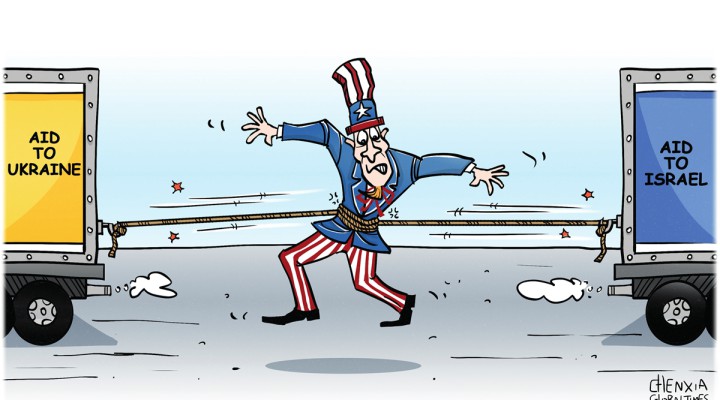US suffers from chronic strategic overreach

The US finds itself sponsoring two conflicts that are at the center of global attention. In Ukraine, the US leads its European allies in supplying weapons, ammunition and economic assistance to the Ukrainian government against Russian forces. And now, in the Middle East, the US is the primary sponsor of Israel as it disproportionately responds to the raids carried out by Hamas on October 7.
In both cases, the US military aid is overstretched.
In Ukraine alone, even US newspapers like the New York Times admit Russia is producing seven times more ammunition than the US and Europe combined. Russia is not only making more ammunition, but it is also making ammunition far cheaper than the West is. This trend can be observed across various types of arms and equipment. Understanding that the fighting in Ukraine is attritional, the West is forced to acknowledge the unlikelihood of a Ukrainian victory.
With fighting breaking out in the Middle East between US ally Israel and Hamas militants, as Israel contemplates a large-scale incursion into Gaza and with the threat of the conflict escalating across the region, the US finds itself attempting to supply both Ukraine and Israel from already depleted stockpiles and with clearly insufficient production rates.
Looming in the background is the conflict the US seeks to provoke with China over the Taiwan question. The US already struggles to fulfill even previous arms deals made with Taiwan authorities. Were conflict to erupt in the Pacific while fighting continues in both Ukraine and the Middle East, the US would find its critically stretched resources even more strained. The possibility of the US achieving any of its current strategic objectives let alone all of them grows increasingly unlikely.
While US policymakers demand expanded production to deal with this obvious and growing problem, it is easier said than done. Expanding military industrial production requires investments in expanding the physical space at factories, investing in additional manufacturing equipment, expanding upstream production facilities, securing more raw materials and obtaining the human resources required for each process. This requires vast investments in both time and money and it is a process that could take years, exceeding the timeframe in which US-sponsored conflicts are unfolding.
The once unquestioned military, economic and political power of the US has significantly waned in recent years, a reality policymakers in Washington refuse to acknowledge as they pursue foreign policy objectives they lack the material means to achieve.
The international “rules-based” order that the US presumes to lead, which includes Washington’s role in deciding which nations in any given conflict are “right” and those which are “wrong,” has begun unraveling. It is a process that many around the globe welcome, and for good reason.
Even at face value, the notion of the US leading an international “rules-based” order that the rest of the world “finds its place within” is problematic. The US accounts for only around 4 percent of the global population. Even the G7 nations combined, which includes the US, only account for 10 percent of the global population. China’s population alone accounts for over 17 percent of the world’s total, and BRICS of which China is a member, accounts for 42 percent of the world’s population.
Why should the US and its allies then dominate global institutions and determine the course of action regarding global crises? Why should the US have the ability to decide how nations manage their internal political affairs, what foreign policies they pursue or the type of economic systems they adhere to?
The short answer is, it shouldn’t. But even if one attempts to formulate an explanation as to why the US should arbitrate the world’s affairs, the reality is that it no longer is capable of doing so.
It was the US’ massive industrial base, immense military power, its leadership in research and development, education and infrastructure relative to the rest of the world that provided it with the power and influence placing it in a position of global leadership following World War II and again after the Cold War ended with the dissolution of the Soviet Union.
However, the world has changed drastically since then. Industry, infrastructure and education have all atrophied not only in the US but across the rest of the G7. Meanwhile, Russia has reemerged as a serious military and industrial power while China has risen as one of the most powerful nations on Earth, in many ways already surpassing the US and soon to surpass the US in other regards.
A combination of internal neglect and increased global competition has placed the US in a difficult if not impossible position to continue pursuing global hegemony. The US is suffering from chronic strategic overreach with no signs of anyone in Washington prepared to reconsider its current foreign policy objectives and its overall role in the world. There is no genuine discussion about the US finding a constructive role to play among all other nations rather than its current obsession with imposing a US-led order upon all other nations.
The reality is, however, despite Washington’s reluctance to have this discussion, this problem cannot be ignored indefinitely. If the US refuses to change the way it deals with the rest of the world, the rest of the world will eventually make the decision for the US. The longer the US delays recognizing and rectifying its relationship with a changing world, the more resources it will have exhausted in futile attempts to maintain a unipolar world, and the fewer resources and leverage it will have to determine for itself the role it seeks to play among a multipolar world.
 TheAltWorld
TheAltWorld 
0 thoughts on “US suffers from chronic strategic overreach”